On a very dark night in 1850 or thereabouts, a small group of people makes their way silently down some dank, dark, and treacherous steps on their way to freedom. Beneath Josiah Tryon’s home are hidden multiple layered basements, and they have just entered the last one.
A baby whimpers in the dark. “Hush!” Her mother glares yet quickly embraces the frightened little one to comfort and keep her from giving them all away… “Slave catchers are lurking everywhere!“
“There were only five African American slaves this time, but it could mean this would be the last crossing to freedom if they were discovered. And a group of twelve are due tomorrow… a lot of lives are at stake!“
Quote given as Josiah stops dead in his tracks and motions everyone to stop.
The Marble Orchard Players, members of the Lewiston Council on the Arts in Lewiston, New York, bring to life these and other ghosts of yesteryear as they portray historical figures in this theater-in-the-street production every fall.
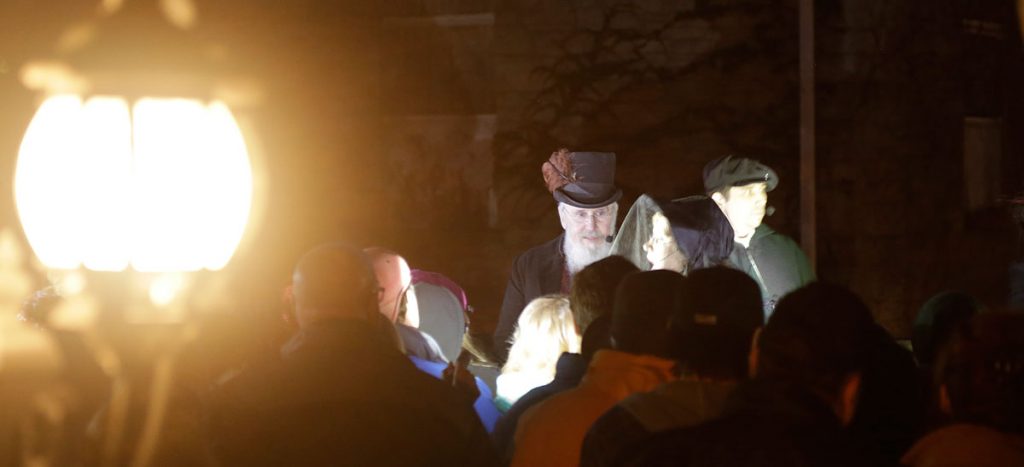
Josiah Tryon, played by Tim Henderson, reminds the guests as they walk toward the cemetery, “We Lewistonians aren’t just a bunch of superstitious fools. We’ve seen evil up close… with our own eyes! We’ve seen the ghosts of little children who never made it to adulthood!”
The Theater-in-the-Streets production by The Marble Orchard Players is based on history and a little artistic license…
“The stories the actors portray are real ones that have been passed down by parents and grandparents over the years,” Don Batalaris, who performs the role of Douglas Graves, told me when we met before the presentation of the Marble Orchard Ghost Walk. The character, Douglas Graves, brings to life the terrifying Tuscarora demon Skedatti said to be “the Screaming Killer of Dogs.“
The Ghost Walk starts in the Peace Garden behind a store at 476 Center Street. Guests walk among the brightly lit shops to the old Marble Orchard cemetery of the Lewiston First Presbyterian Church, 33 Cayuga Street, Lewiston, NY, where those heroic and some-not-so-nice souls of yesteryear are laid to rest. A far different atmosphere than the silent steps taken on the inky nights of yesteryear.
The Theater-in-the Streets Ghost Walk takes place from mid-September through October on Saturdays each year. It is a lot of fun, always with some new twists to awe, frighten, and inspire onlookers to more noble ambition.
It was a pleasure to be invited to photograph and talk to the Marble Orchard Players before a performance. We met at the historic Lewiston First Presbyterian Church, est. 1817, which had a big part to play in the Underground Railroad in Lewiston.

It is as if the very contrails offer up exclamation marks above a church so steeped in history. A congregation filled with ordinary townsfolk standing up for principles, freedom, and justice.

Josiah Tryon, son of Josiah and Mary Sage Tryon, of Wethersfield, Hartford, Connecticut, was born there in 1798 and passed away in 1886 at Lewiston. He is buried in the Marble Cemetery, so named for its marble gravestones. Josiah and his wife Mary moved to Lewiston in about 1835.
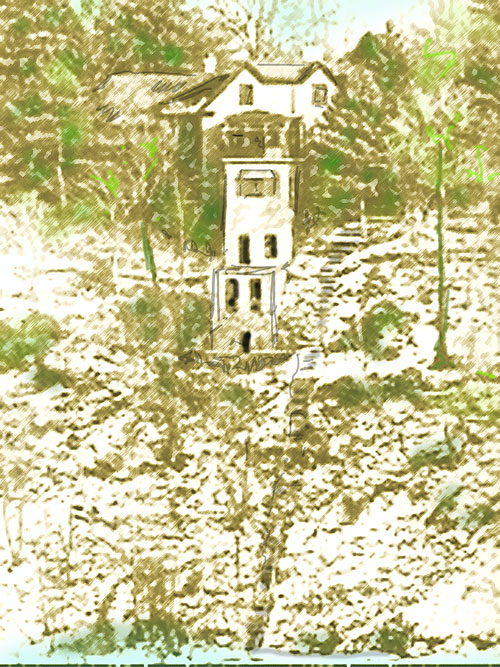


As an abolitionist leader, Josiah Tryon, along with his brother, Amos Tryon, and business partners Augustus and Peter Porter, operated a shipping business that they used as a front to smuggle escaping slaves across the Niagara River.
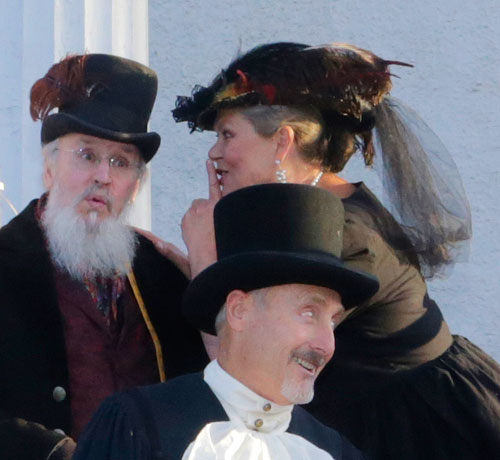

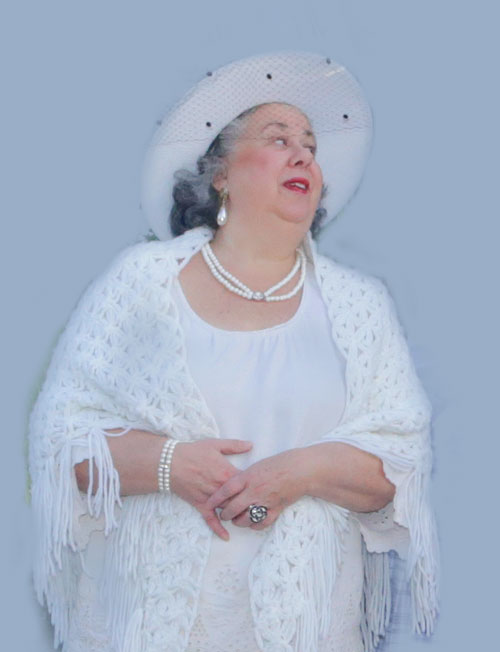
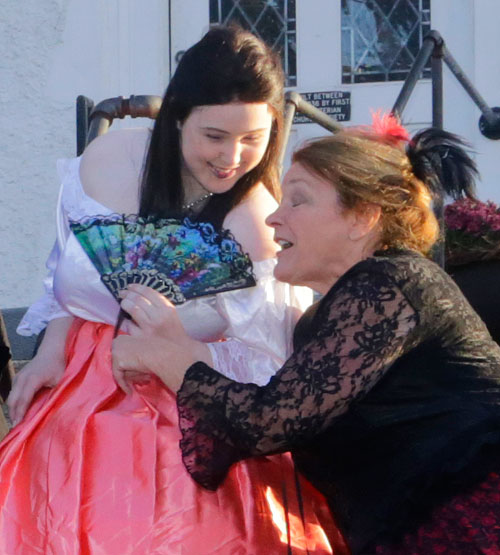
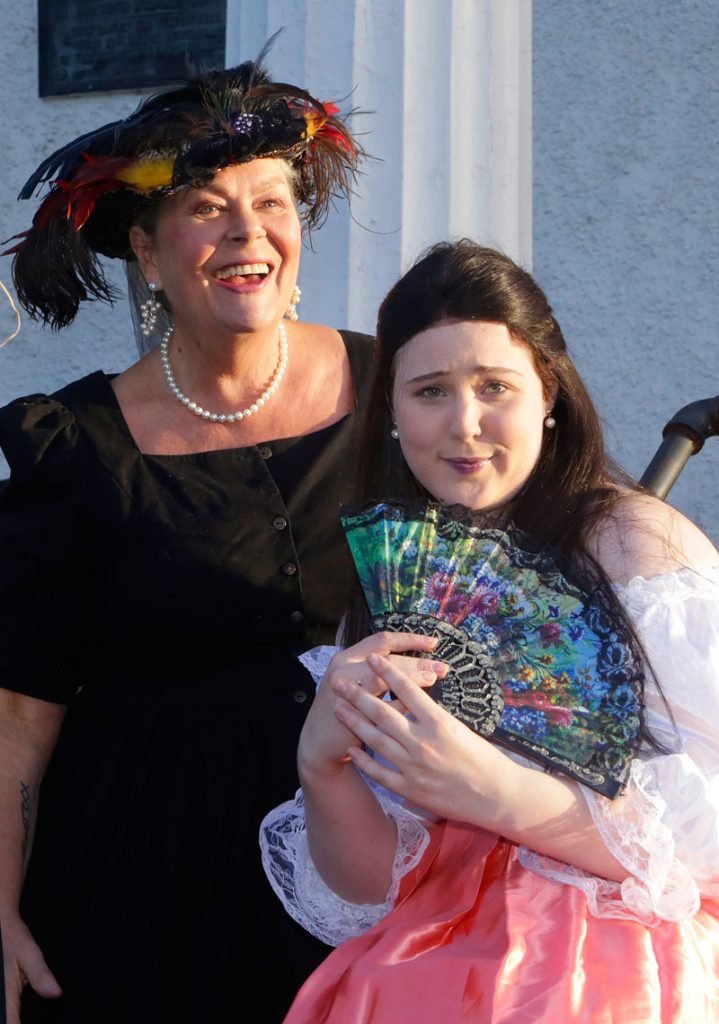

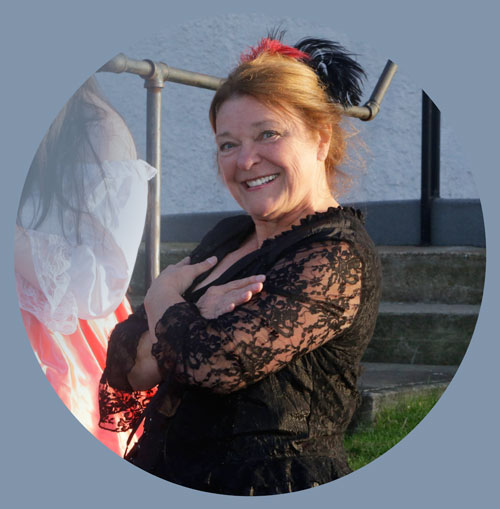
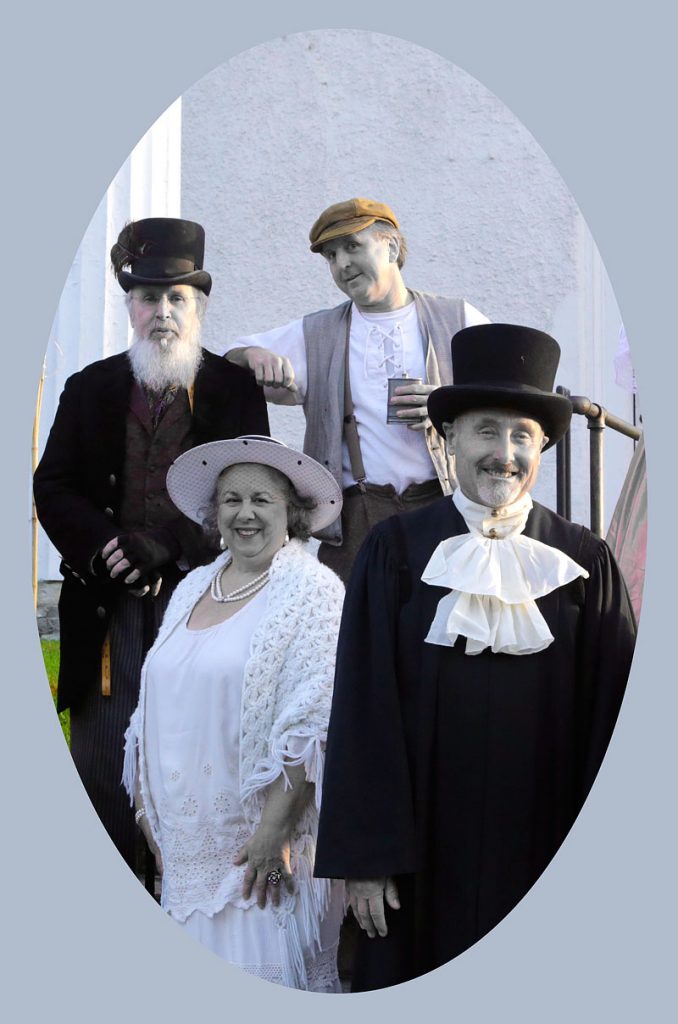
The Lewiston Stop… on the Underground Railroad
Josiah Tryon was an industrious fellow. He was also a skilled tailor, which he used to his great advantage. As an ingenious subterfuge, he made friends with many a slave catcher, gifting them bright, stylish-colored jackets. This meant that everyone in town could identify them! The jackets signaled to the townspeople that these were slave catchers, and they were to keep ‘mum’ about the Underground Railroad and its participants.
This strategy was so effective that no one in town ever betrayed the code of silence to keep the slaves hidden and safe.
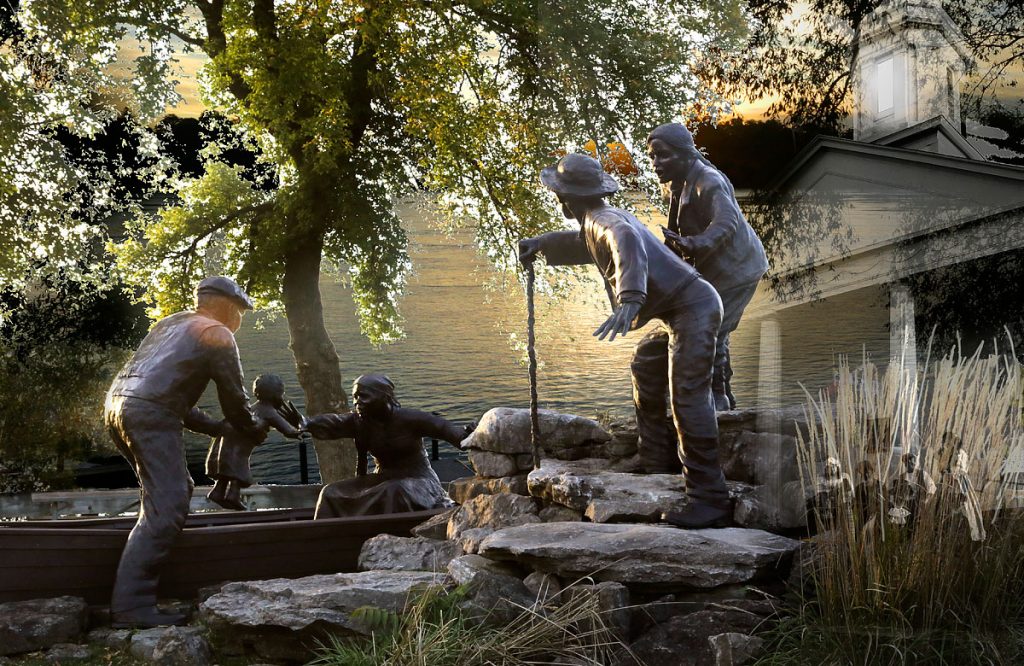
The Lewiston First Presbyterian Church church steeple would be lit up on nights when there was a crossing so that those on the other side in Upper Canada would be ready to help the escapees. Stories told only in secret or by the light of a fire on a dark night.
Josiah was affectionately referred to as the Underground Railroad’s ‘Station Master’ for Lewiston.
African American slaves began seeking freedom by crossing the Niagara River into Canada after the War of 1812. Word had spread that there were ‘Free Black Men in British Red Coats’ as numbers of enslaved servants of United States Military Officers returned from battle to the southern states. It had taken a while for the 1793 Act to Limit Slavery, to become widely known. It is said that between 30,000 and 40,000 men, women, and children arrived safely to a new life across the border.
The 1793 Act stated, “Any enslaved person who reached Upper Canada (British North America at the time) became free upon arrival.”
The word that freedom could be had in Canada spread far and wide following the War of 1812. Many a perilous journey was made going north by freedom-seekers. The American Fugitive Slave Act, which empowered slave catchers to pursue fugitives in Northern states, created the need for some way for the slaves to make it to Upper Canada.
This resulted in a network of both blacks and whites who were secret ‘abolitionists,’ calling the route the ‘Underground Railroad.’
In many instances, people like Josiah Tryon, people of conscience, and churches -like the ‘Lewiston First Presbyterian Church’ took part in the Underground Railroad to Freedom.
Guests are enthralled as the story unfolds along with the ‘Walk’ striking emotional terror in their imaginations …such as through the account by Catherine Hustler, played by Kathryn Serianni, as she calls out a memory…
“You know, a little boy was scalped right here! In that awful War of 1812.”
Everything was different in the 1800s. It is hard to put things we know today in that framework, for instance, about ‘the curious and creepy’ things surrounding Lewiston’s history. In those days, there was not the technology we have today, and several people were actually BURIED ALIVE!
The Morgan Affair…
During the walk, there are inferences to the ‘Morgan Affair’ of 1826. William Morgan disappeared in a remote corner of upstate New York, was kidnapped, and was thought murdered for presumably giving away some Masonic Lodge secrets. This event set off 25 years of anti-Masonic hysteria.
Sally Tryon, played by Eva Nicklas, further gossips into a willing ear… “About the ‘Morgan Affair,” That old lady who lived behind the Frontier House saw the whole thing. She saw the Sheriff and his men DRAG William Morgan kicking and screaming bloody murder into that carriage.”
Josiah seemingly had a knack for being in the right place at the right time. He was named as a witness to the kidnapping of William Morgan.
‘Mrs. Smith, played by Claudia Carnes, claiming to know all about it, secretly exclaims to a friend, “I overheard my husband talking to some of his ‘Masonic Brethren’ that night, all inflamed with hatred and fueled by drink… They were sure that Morgan drifted down to the bottom of Lake Ontario, aided by the weight of a rock tied to his leg. His throat was slit from ear to ear, his tongue ripped out by its roots…” and continuing the account, “Well, some said it was a proper Masonic punishment, you know.”
Witch Hazel, a character she invented herself, is played by Eva Nicklas. Witch Hazel bemoans sadly her ability to cast spells, “Yesksksksksks….. I blinded him… I blinded him to the charms of other women because you see, I would rather go blind, myself, than to see him in the arms of another!”
The Marble Orchard Players is a cast of volunteer actors inspired to bring the stories of Old Lewiston to life.
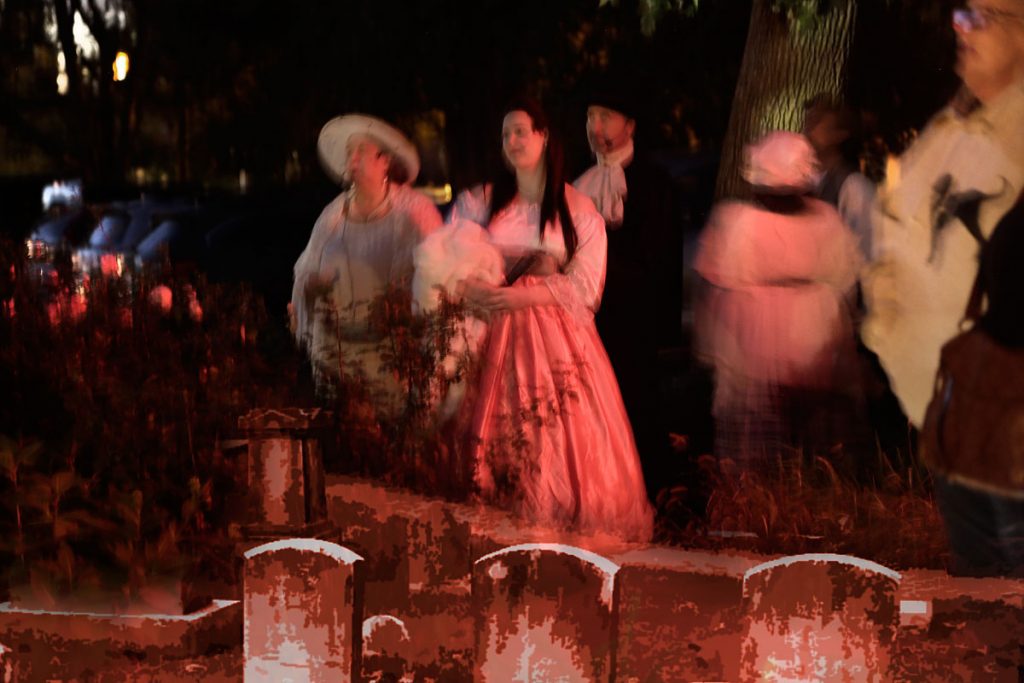
Many thanks to the Cast of Actors who gave amazing performances, thoroughly enthralling the audience.
- Eva Niklas, as the infamous ‘Sally Tryon’ (believed to be a ‘Tryon’ of another generation), portrays herself as Witch Hazel.
- Tim Henderson, as ‘Josiah Tryon’ from 1798 to 1886, was a tailor, shipping company operator, and Underground Railroad Conductor.
- As ‘Catherine Cherry Hustler’ (1762 to 1832 buried in First Presbyterian Church Cemetery, Lewiston), Kathryn Serianni was a colorful character who ran Hustler’s Tavern in Lewiston village in the early 1800s with her husband, Thomas Hustler. Catherine invented the cocktail, stating, “It warms both body and soul and is fit to be put in a vessel of diamonds.” It is reported that she playfully used a rooster feather to stir it.
- Claudia Carnes, as Mrs. Smith, who claimed to know ALL about William Morgan’s murder,
- Anna Frankovitch, as Anna Gillette, saw her brother being scalped in the War of 1812.
- Eva Frankovitch, as ‘Frozen Charlotte,’ whose vanity caused her to freeze to death.
- Don Batalaris, as ‘Douglas Graves’ witness to the Tuscarora demon ‘Skedatti,’ who was said to be ‘the Screaming Killer of Dogs.’
- Justin Higner, as ‘Captain James Van Cleeve,’ who had commanded several steamers. One of his last commands was the Bay State, a big steamer built in Clayton. He served as secretary-treasurer and general manager of the Ontario and St. Lawrence Steamboat Company in 1852, and its line ran between Lewiston, New York, and Montreal. River Steamers were “expressly adapted for navigation of the rapids,” which connected the railroad terminals at Oswego and Ogdensburg, NY, and points downstream. A second route, the American Express Line, ran from Niagara Falls, NY, to Montreal, with a stop-off in Toronto. Van Cleve was also an avid watercolor painter. Source: Maritime Tales of Lake Ontario by Susan Peterson Gateley.
- Lynda LaGreca as Nina Starkweather, the aging spinster with a broken heart;
- John Jacoby as Judge Sherborne Piper, the ‘Hangin’ Judge;
- Lilu Wilson as Mary Agnes, who was buried with her beloved baby doll.
The audience joining the Marble Orchard Players along the walk was an eager crowd of locals who come each year, at least once, to witness the historical reenactment and tourists who’ve heard of Lewiston’s marvelous and mysterious history, even from as far away as Europe!
Historic Lewiston attracts tourists from all over the world. The ‘Lewiston Landing’ dates back to 1615. French priest Fr. Louis Hennepin joined the explorer LaSalle (René-Robert Cavelier, Sieur de La Salle, November 22, 1643 – March 19, 1687). LaSalle arrived here in 1678 to explore the area, sail the Great Lakes and discover the northern part of the Mississippi River. A chapel and fortified cabin later became Chabert Joncaire’s Trading Post in 1721.
Many a twist and turn of plot and characters await the guests, surprises amid suspense! But I won’t spoil any of it…
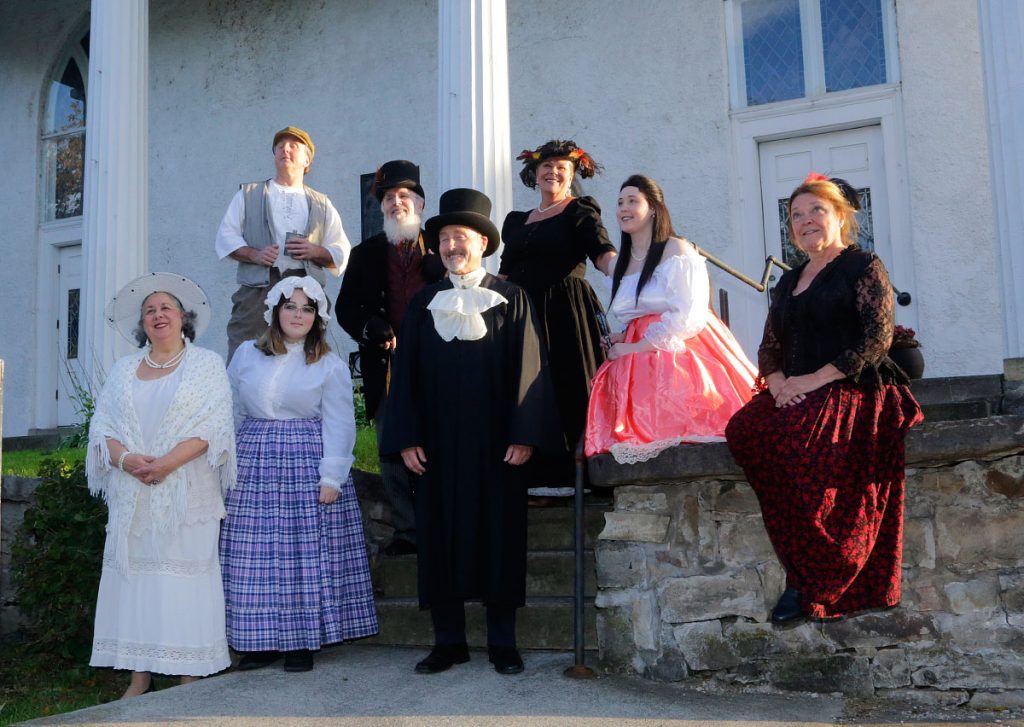
at the photography session.
Lewiston Council on the Arts brings together artists of all disciplines and promotes family-friendly art in the Upstate New York community. To see a presentation about Iroquois Arts and Culture, click this link.

for mentions of creative people, books, products, or businesses mentioned in this post.




Pingback: Lewiston Council On The Arts Awarded Prestigious Spark Award! - Astoria Magazine
Pingback: Attend Lewiston, NY Marble Orchard Ghost Walk - Astoria Magazine
It really was a lot of fun, everyone should see it!
Dear Trina and friends at Astoria Magazine, Thank you! Thank you! Thank you for all the wonderful descriptions and colorful photos! We are grateful to you for coming to our production and appreciate you sharing your observations and sharing them to the wide, wild world of the internet!!!! Glad to know you had as much fun as we do!!!!!